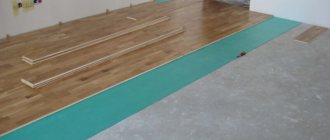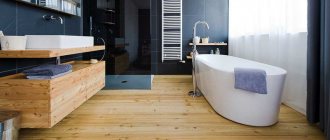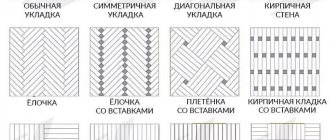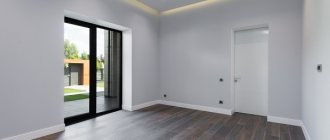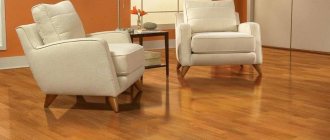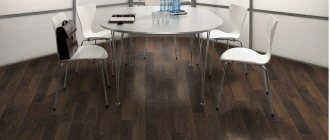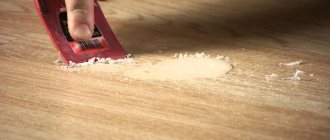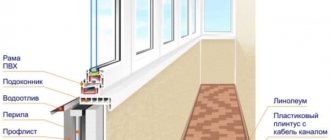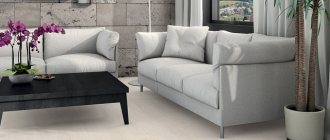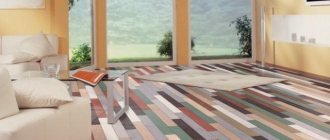When doing renovations, choose the finishing materials wisely. When you reach the floor, keep in mind that it is an important attribute in the house. The final floor covering must be wear-resistant and aesthetically pleasing. Laminate flooring would be an excellent choice. It is natural, durable, beautiful in appearance, suitable for use in residential and non-residential premises.
Laminate is the best flooring option
Waterproof laminate in the kitchen advantages and disadvantages
When starting to arrange the floor in the kitchen, keep in mind that housewives regularly prepare food here. It will be affected by temperature changes, high humidity, and in the kitchen liquid is often spilled, cutlery falls, and grease stains appear.
When choosing laminate flooring for your kitchen, be sure to choose a moisture-resistant material. Since ordinary panels will quickly become unusable under the influence of the above negative factors.
Of course, even moisture-resistant slats cannot be filled with water; it is recommended to wash them not with a wet, but with a slightly damp cloth.
Listing the main advantages of this coating we can note:
- attractive appearance;
- hygiene, hygroscopicity;
- simple installation, ease of further maintenance;
- excellent heat and sound insulation qualities.
It is pleasant to walk on this floor in slippers, barefoot. It is warm and pleasant to the touch. Laying laminate flooring will cost you much less than linoleum or ceramic tiles. A special laying technology allows it to be laid throughout the home with a smooth and beautiful transition between rooms.
It is best to choose a waterproof laminate for the kitchen
Removing stains
Some stains are very difficult to clean. But even the most difficult to remove stains can be combated using both folk remedies and special chemicals. Since the latter are not cheap and are often not available at the right time, pay attention to the home cleaning methods presented in the table.
Table - Methods for eliminating heavy contaminants
| Type of contamination | How to clean laminate flooring |
| Stains of tea, watercolor paints | — Baby shampoo; — dishwashing detergent; - baby liquid soap |
| Wine and cognac stains | - Ethanol; - shampoo for children |
| Traces of markers, pencils, lipstick | — Triple cologne; - methyl alcohol |
| Gum | — Acetone (after freezing with ice); - nail polish remover |
| Oily stains | — Windshield wiper; - acetone |
| Ink | — Washing powder; - ink remover |
| Shoe marks | — Regular eraser; - warm water |
| Blood | — Windshield wiper; - hydrogen peroxide |
| Shoe polish | — Acetone; - nail polish remover. |
How else can you wash laminate flooring to avoid streaks? For light-colored surfaces, use baking soda by adding a tablespoon to a liter of water. And if you want to eliminate stains and make dark laminate shine, use citric acid.
Video on the topic
Advantages of using impregnation to protect against water
Protecting laminate flooring from moisture is a major requirement in the kitchen. The main advantages of using impregnation include increasing the service life of the floor covering. In the most vulnerable places it is necessary to apply a special impregnation. It is necessary to carefully process all joints and locking joints. This will provide good protection against moisture penetration, and will save owners from constantly repairing the floor or partially replacing it in areas of damage. A properly chosen moisture protection agent at the joints will be a reliable barrier against water getting into them.
Laminate must be protected from moisture
Composition of sealants
After drying, the sealant is an elastic rubber seal for laminate seams. Accordingly, it contains components that provide strength, the ability to withstand vibration, and dynamic loads. The basis of the sealant is silicone or acrylic, which meets all the specified requirements.
The products also contain various plasticizers, viscosity-reducing organic extenders, and mineral compounds. Other possible components of sealants are:
- antiseptics and fungicides,
- quartz flour,
- chalk.
Colored sealants additionally contain coloring agents (pigments). They are designed for specific laminate shades and most often come in grey, dark brown, wood tones. There are also transparent, colorless products on sale that are suitable for any type of material and are practically invisible on it.
Which impregnation should I choose?
The construction market offers a wide range of impregnations for laminate flooring. Natural wax is an excellent choice. It is used not only for protection against water, but also for proper installation of panels. It is applied to the locks on both sides. The use of wax will prevent the coating from squeaking during operation.
Also, joints with connections can be treated with a special mastic. In addition to good protection from moisture, it will improve the quality and durability of locks. After treatment with mastic, water, dust, and dirt will not get into the joints and locks. The advantages of using it include:
- strong connection of all floor elements;
- high protection against moisture;
- no accumulation of dust and dirt;
- excellent protection against mechanical damage.
It is not difficult to choose an impregnation for laminate flooring.
Using mastic you can get rid of scratches and minor defects on the floor. But if during production the product has already undergone preliminary protection from moisture, then re-processing should be abandoned.
Please note that all protective products can be glossy or matte. This should definitely be taken into account when purchasing. If you apply matte mastic on a glossy surface, it will become covered with streaks and the panels will take on an untidy appearance. You can use a special film as protection. It must be glued on top of the floor covering. This film is completely safe. It does not release any toxins and does not cause allergic reactions.
Various sealants containing silicone are also popular. They can be applied to the slats both during the installation of the floor covering and in the cracks that appeared after installation.
Protectants can be glossy or matte
Base requirements
There are a number of requirements that apply to all types of bases for this floor covering. These include:
- Evenness. The maximum permissible difference in height is 2 mm per 2 linear meters of surface length.
- Purity. Fine sand and dirt particles remaining under the laminate create an unpleasant squeaking sound when moving on it.
- Uniform slope. This parameter should not exceed 4 mm per 2 m2 of room.
- Dryness. Any substrate must be allowed to dry thoroughly before applying primer. Otherwise, this may lead to swelling of the coating.
Laminate processing methods
Above we looked at how to protect laminate flooring from water. After all, this material is expensive, and in order to prevent its premature deterioration and loss of its original appearance, it is necessary to treat it with various impregnations.
When purchasing impregnation, pay attention to what protection was applied to it during production. If the manufacturer indicated that in the manufacture of its products it used paraffin or mastic on the joint locks, then you will not need additional protection from moisture. Such products are produced only by well-known and well-established brands.
Some manufacturers provide products in already processed form
To process and lay the panels you will need to take:
- gloves, safety glasses;
- restorative;
- sponge;
- soft rags.
The installation of panels must be done in accordance with the requirements and recommendations of the manufacturer.
If you are concerned about the question of how to protect laminate flooring from moisture, then you need to carefully prepare for this process. Clean the floor from dust and dirt. Laminate flooring can only be laid on a dry and flat surface.
When processing laminate, take care of protective equipment
Functions of primer mixture
The main purpose of the primer is to ensure good adhesion of one treated material to another, called adhesion. But besides this, the mixture performs a number of additional functions, which include:
- Binding of dust particles on the surface being treated, which often prevents the materials from bonding.
- Strengthening the base structure by filling voids and creating powerful bonds between layers of material. Such mixtures are called deep penetration primers.
- Ensuring the moisture resistance of the base.
- Protecting the floor from mold damage, which destroys the material and also negatively affects human health. Coatings with fungicidal additives have this property.
Causes of laminate swelling
There can be several reasons for the swelling of the lamellas, and they can also be expressed in different ways. When they swell, waves and irregularities appear on them. The main causes of bloating are: poor preparation during installation. If the base is poorly prepared, the finished floor covering will soon begin to deform. In this case, the swelling can be corrected only by complete dismantling. After this, you will have to level the base and lay the flooring in a new way. Damaged panels will need to be replaced with new ones.
If a small amount of water gets on the slats and you immediately wipe it off, the impregnated material will not be damaged or swell. But if water gets on the material regularly, it will lead to swelling. Especially if gaps have appeared between the seams during operation.
There can be several reasons for laminate swelling
Use of low-quality material. Cheap slats swell on their own. The situation can only be corrected by completely replacing them.
Violation of installation technology. If the temperature conditions were not taken into account during installation or if the panels were glued to the base under conditions of high humidity or temperature changes, the material will begin to warp.
Laminate swells at joints for two reasons.
- Poor quality locks made from cheap materials.
- The underlay selected is the wrong thickness. If a thick backing is placed under a thin material, this will lead to the slats being pushed through and the locks cracking.
The material can also swell due to improper use.
Blistering may occur due to improper installation
Application technology
Typically, seams are treated with sealant when laying new laminate flooring. It is also recommended to do sealing during the restoration of the old coating with parallel sealing of chips, cracks, and other defects. The sealant is applied without gaps, completely. Tips for doing the job:
- it is necessary to form the joint correctly so that the seam between the individual elements does not limit freedom of movement,
- The sealant should not get on the bottom or top of the lamellas - it is applied only to the sides, otherwise the risk of seam rupture under load increases,
- When filling wide joints, it is advisable to use cellophane covers on the front side, which will protect the elements from sealant.
To apply the product, take a tube with a sharp tip or a bottle inserted into a gun. The tip of the package is placed in the groove of the lamella at an angle of 45 degrees, and the composition is squeezed out in an even strip. When working with a mounting gun, it is much easier to achieve uniformity of the layer than when using tubes.
Excess sealant is removed with a narrow spatula, previously moistened with water. After that, the planks are connected, and a small amount of sealant protrudes onto the surface: it also needs to be removed, but only after 15-30 minutes, when polymerization occurs. It is better to use a plastic spatula for this; a metal one can leave scratches.
If the old coating is being restored, the previous layer of sealant (if any) must be removed in advance. This can be done mechanically: by picking it up with a spatula and tearing it off with a strip. Remains of sealant must be washed with a solvent. Before coating the laminate with a new product, the elements must be wiped with a soft cloth.
How to fix defects
Removal of swollen lamellas can be carried out without disassembling the row to achieve positive results. If the swelling occurs in a small area, you need to dismantle the floor covering and replace the damaged slats with new ones.
If the panels are swollen due to temperature changes, this problem is resolved as follows.
- We remove the baseboards.
- We take out the outer slats.
- We cut the edge with a hacksaw.
- We carefully place the cut lamellas in their original place.
- We install skirting boards.
After a few days, the “behaved” material should return.
The problem of bloating can be corrected in several ways. It depends on the reasons for their occurrence
If the material is swollen from moisture, you must:
- remove furniture from the room;
- open the windows and let the panels dry;
- You can try drying them with a hairdryer. It takes 3-5 days to dry the laminate.
If it was not possible to eliminate the defects in this way.
- Remove the damaged area. In this case, number the boards on the wrong side.
- Remove moisture from the base and leave the floors disassembled for 5 days.
- Remove any mold or damage that appears. Treat the lock joints with wax or oil.
- Place the slats in place according to their numbering.
- If the slats are completely damaged, replace them with new ones.
To avoid such problems, purchase high-quality and proven material. To do this, you will have to study its technical characteristics and reviews from previous customers. Be sure to lay the material only on a carefully prepared base with thick plastic film. Do not forget to leave gaps between the walls and slats of at least 1.2-2 cm. Treat all joints and interlocking joints with impregnations or water-repellent compounds.
To avoid such problems, you need to choose quality material
Laminate floor care
As for operation, it is recommended to wipe the floors with a well-wrung out cloth. If liquid gets on the floor, it must be removed immediately. When stains appear, you need to get rid of them using special powders and gels. Use a nylon rag when doing this.
You need to wipe the floor with a well-wrung out cloth.
If candy falls on it, wait until it dries, then carefully scrape it off. If you use scrapers or hard sponges when caring for the material, it can be damaged.
If laminate is laid in the kitchen, then a rubber mat should be laid near places such as the sink. Dry debris or dust can be removed using a vacuum cleaner. It is recommended to do wet cleaning no more than once a week. Do not leave puddles on the surface. Do not use abrasive or aggressive detergents. Remember, hot water has a negative effect on the flooring.
Make sure there are no puddles or water on the floor, this will negatively affect the coating
Beeswax
We are talking about a special wax for laminate flooring that protects the material from the negative effects of environmental factors. For application, you can use a regular brush; it is better to do this while styling. Use tissues to remove excess. The thick wax that comes in a tube is applied in a thick and continuous layer, and the hardened excess is removed after the installation work is completed.
Wax for laminate
What to do in case of flooding
If there is a flood in your kitchen, take the following measures immediately.
- Wipe the slats dry.
- Remove the baseboards and remove all water under the backing.
- Check the panels for damage from contact with water.
- Laying the panels in place should be done a few days later, after they have completely dried.
- If it is impossible to correct the deformation of the panels, simply replace them.
To summarize, it can be noted that laying laminate flooring in the kitchen is a good idea. If installation technologies are followed, joints are protected, and with proper operation, it will last 20 years, pleasing with its aesthetics, ease of use, and practicality.
